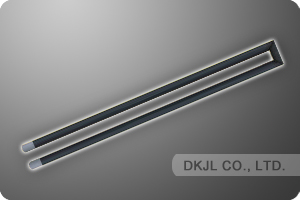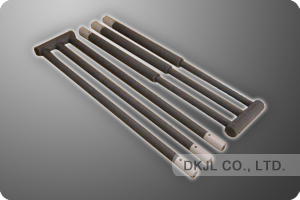Heating Element£º
1. SW (Standard) 
SW Silicon Carbides are used in applications ranging in temperature from 600¡æ up to 1500¡æ in both air and controlled atmospheres. Although the type of atmosphere used will determine the maximum recommended element temperature. This kind of silicon carbide elements can be mounted either vertically or horizontally. The elements of our product are available in the range of 10 to 54mm diameter. The total length can vary up to 4500mm.
|
Diameter |
Length
of
Hot zone |
Length
of
Cold End |
Overall Length |
Resistance |
|
Diameter |
Length
of
Hot zone |
Length
of
ColdEnd |
Overall Length |
Resistance |
|
8 |
100-300 |
60-200 |
240-700 |
2.1-8.6 |
30 |
300-2000 |
250-800 |
800-3600 |
0.4-4.0 |
|
12 |
100-400 |
100-350 |
300-1100 |
0.8-5.8 |
35 |
400-2000 |
250-800 |
900-3600 |
0.5-3.6 |
|
14 |
100-500 |
150-350 |
400-1200 |
0.7-5.6 |
40 |
500-2700 |
250-800 |
1000-4300 |
0.5-3.4 |
|
16 |
200-600 |
200-350 |
600-1300 |
0.7-4.4 |
45 |
500-3000 |
250-750 |
1000-4500 |
0.3-3.0 |
|
18 |
200-800 |
200-400 |
600-1600 |
0.7-5.8 |
50 |
600-2500 |
300-750 |
1200-4000 |
0.3-2.5 |
|
20 |
200-800 |
250-600 |
700-2600 |
0.6-6.0 |
54 |
600-2500 |
300-750 |
1200-4000 |
0.3-3.0 |
|
25 |
200-1200 |
250-700 |
700-2600 |
0.4-5.0 |
|
|
|
|
|
2. U-TYPE
U shape Silicon Carbide is consists of two silicon carbide rod with same diameter. Each rod has both hot zone and cold end with identical resistance. Two rods are connected by the low resistance SiC. Also the connector could be used as holder according to different requirements.
|
Diameter
|
Length of Hot zone |
Length of Cold End |
Centre distance |
Diameter of Centre |
Length of Connector |
|
14 |
400 |
300 |
30 |
22 |
55 |
|
16 |
400 |
300 |
35 |
25 |
60 |
|
20 |
500 |
400 |
40 |
30 |
70 |
|
25 |
700 |
450 |
55 |
38 |
90 |
|
30 |
1500 |
650 |
65 |
45 |
110 |
|
35 |
1500 |
650 |
90 |
45 |
120 |
|
40 |
2400 |
850 |
110 |
56 |
150 |
3. W-TYPE 
3-phase elements are available in 2 different types: SGC (Dumbbell), SGD(Standard).
These elements are self-bonded silicon carbide formed by re-crystallization of silicon carbide at high temperature. It consists of three high-purity silicon carbide rods connected at one end by a silicon carbide crossbar. The joints, also formed from silicon carbide, fully bond the components into a structurally homogeneous body. SGC elements are designed for vertical installation in standard float glass bathes and SGD elements for horizontal installation. They can be connected directly on three-phase power supply and is a one-side terminal type which permits drawing out the terminals from the roof of the furnace. All elements can be delivered with a wide range of accessories for trouble-free and energy-saving operation.
|
Diameter
|
Length of Hot zone |
Length of Cold End |
Centre distance |
Diameter of Centre |
Length of connector |
|
14 |
400 |
300 |
30 |
22 |
90 |
|
16 |
400 |
300 |
35 |
25 |
95 |
|
20 |
500 |
400 |
40 |
30 |
120 |
|
25 |
700 |
450 |
55 |
38 |
140 |
|
30 |
1500 |
650 |
65 |
45 |
170 |
|
35 |
1500 |
650 |
90 |
45 |
190 |
|
40 |
2400 |
850 |
110 |
56 |
230 |
4. ST-TYPE
SiC heating elements have an exceptional service life and have an excellent performance in a wide range of application with corrosive atmosphere, particular in the glass industry. Various kinds of coatings are available upon request in order to improve the durability of the elements even under the harshest furnace conditions.
|
Diameter |
Length of Hot zone |
Length of Cold End |
Length of low resistance |
|
25 |
400 |
350 |
300 |
|
30 |
400 |
350 |
300 |
|
35 |
500 |
350 |
300 |
|
40 |
500 |
350 |
300 |
5. Single Spiral Silicon Carbide and Double Spiral Silicon Carbide:
Features:
1) It is made from silicon Carbide powder
2) Its name is single or double sprial silicon carbide heating element
3) It is widely used in all kinds of kilns and furnaces.
|
Outside Diameter |
Inside Diameter |
Length of Hot zone |
Length of Cold End( max) |
Length of Cold End( minimum) |
|
30 |
18 |
300 |
250 |
250 |
|
35 |
23 |
300 |
300 |
300 |
|
40 |
26 |
300 |
300 |
300 |
|
40 |
30 |
400 |
400 |
40 |
|
50 |
40 |
500 |
450 |
40 |
|
60 |
50 |
700 |
160 |
40 |
|
70 |
60 |
700 |
160 |
40 |
|
80 |
70 |
800 |
160 |
40 |
|
90 |
80 |
800 |
160 |
40 |
6 . Notes of Installation:
1) Hot Rod should be protected against damp during storing and setting so as to improve the durability and performance of the rod.
2) In order to be sure of well-distributed furnace temperature and Rod loading ,groups should be divided before installation. The tolerance of resistance of each group can not exceed 10%.
3) Because rod is hard and brittle, please be careful when installing and maintaining so as to avoid damage.
4) When operating the electric furnace at the beginning , thevoltage should be increased slowly and can not be fully loaded one time. Otherwise the larger current will damage the Rod.
5) When individual rod is damaged and needs to be changed,a new one should be used according to the increasing resistance . if many are damaged or resistance increased too much, all the rods should be changed.
7. The influence of Operating Temperature and Surface Load on the Rod surface in a different
|
atmosphere |
Furnace Temperature£¨¡æ£© |
Surface Load£¨W/cm2£© |
The influence on the Rod |
|
Ammonia |
1290 |
3.8 |
The action on SiC produces methane and destroys the protection film of SiO2 |
|
Carbon dioxide |
1450 |
3.1 |
Corrode SiC |
|
Carbon monoxide |
1370 |
3.8 |
Absorb carbon powder and influence the protection film of SiO2 |
|
Halogen |
704 |
3.8 |
Corrode SiC and destroy the protection film of SiO2 |
|
Hydrogen |
1290 |
3.1 |
The action on SiC produces methane and destroys the protection film of SiO2 |
|
Nitrogen |
1370 |
3.1 |
The action on SiC produces insulating layer of silicon nitride |
|
Sodium |
1310 |
3.8 |
Corrode SiC |
|
silicon dioxide |
1310 |
3.8 |
Corrode SiC |
|
Oxygen |
1310 |
3.8 |
SiC oxidized |
|
Water-vapor |
1090-1370 |
3.1-3.6 |
The action on SiC produces hydrate of silicon |
|
Hydrocarbon |
1370 |
3.1 |
Absorb carbon powder resulted in Hot pollution | |